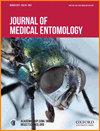巴西马拉尼昂州的时空风险集群、社会脆弱性以及皮肤利什曼病监控重点地区的确定:一项生态研究
IF 2
3区 农林科学
Q1 ENTOMOLOGY
引用次数: 0
摘要
皮肤利什曼病(CL)是一种被忽视的疾病,广泛分布于巴西马拉尼昂州,是一个严重的公共卫生问题。然而,人们对其传播动态和决定性因素并不清楚。在这种情况下,地理空间技术有助于解释这一过程。因此,本研究描述了巴西东北部一个地方病流行区的时空动态以及社会脆弱性对 CL 的影响。这是一项关于马拉尼昂州 2007 年至 2020 年新增慢性淋巴细胞白血病病例的生态学研究,研究数据直接来自应报告疾病信息系统。采用空间经验贝叶斯方法对发病率进行了平滑处理。随后,确定了全球和地方莫兰统计数据及其与社会脆弱性指标的关联。疾病分布不是随机的,而是在空间和时间上分组的。所有社会脆弱性指数域都与 CL 发病率呈正相关。2007年1月至2013年12月期间,在马拉尼昂州西部(P< 0.001)发现了一个可能的集群,该集群包括18个市镇,相对风险较高(5.06)。研究结果表明,应优先在这些地区规划公共卫生行动和分配资源,以帮助有效降低该疾病的发病率。本文章由计算机程序翻译,如有差异,请以英文原文为准。
Spatial-temporal risk clusters, social vulnerability, and identification of priority areas for surveillance and control of cutaneous leishmaniasis in Maranhão, Brazil: an ecological study
Cutaneous leishmaniasis (CL) is a neglected disease widely distributed in Maranhão, Brazil and presents a significant public health problem. However, its transmission dynamics and determining factors are not clearly understood. In this context, geospatial technologies help interpret the process. This study, then, characterized the space–time dynamics and the influence of social vulnerability on CL in an endemic area in Northeast Brazil. This is an ecological study about new cases of CL in Maranhão, from 2007 to 2020, obtained directly from the Notifiable Diseases Information System. The incidence rate was smoothed using a spatial empirical Bayesian method. Subsequently, global and local Moran statistics and their association with social vulnerability indicators were determined. Disease distribution was not random but grouped in space and time. All Social Vulnerability Index domains were positively correlated with the CL incidence. A likely cluster was detected in western Maranhão (P < 0.001), which encompassed 18 municipalities, from January 2007 to December 2013, with a high relative risk (5.06). The research findings suggest that planning public health actions and allocating resources should be prioritized in these areas to help effectively reduce the incidence of the disease.
求助全文
通过发布文献求助,成功后即可免费获取论文全文。
去求助
来源期刊
CiteScore
4.60
自引率
14.30%
发文量
207
审稿时长
3-8 weeks
期刊介绍:
Journal of Medical Entomology is published bimonthly in January, March, May, July, September, and November. The journal publishes reports on all phases of medical entomology and medical acarology, including the systematics and biology of insects, acarines, and other arthropods of public health and veterinary significance. In addition to full-length research articles, the journal publishes Reviews, interpretive articles in a Forum section, Short Communications, and Letters to the Editor.

 求助内容:
求助内容: 应助结果提醒方式:
应助结果提醒方式:


